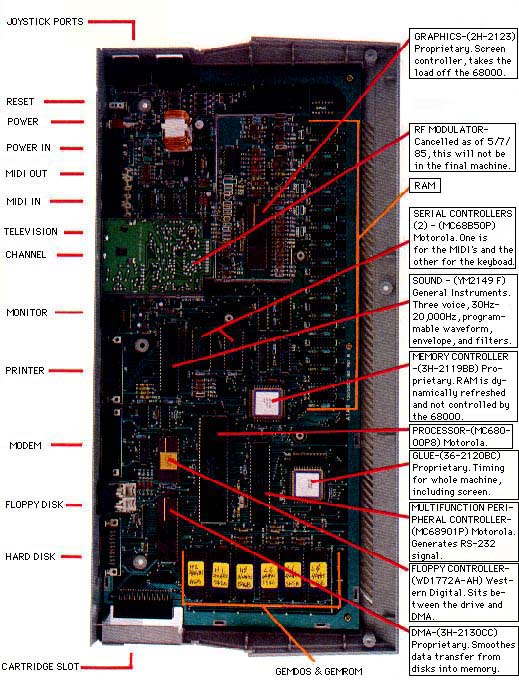INTERIORS
Opening up the 520ST
by JACK POWELL, Antic Technical Editor
You're looking at the back and the interior of Antic's $5,500 development model Atari 520ST. The machine you get off the shelves may look a little different, but the basic architecture will remain the same.
The $5,500, by the way, was not just for the hand-assembled computer. It also bought Antic two 3.5" disk drives, one 10-megabyte hard disk, a medium-resolution (640 x 200) RGB analog monitor, a high resolution (640 x 400) monochrome monitor, and one mouse. (Actually, we're still holding IOU's for the hard disk and the high-res monitor.)
The software in the package is the C language compiler, machine language assembler and debugger by Digital Research, the Mince screen editor by Mark of the Unicorn, Kermit – a modem protocol program for file transfer, GEMDOS, and, of course the GEM operating environment – both of which are in ROM in our machine.
With all of this came 1,000 pages of highly technical documentation.
THE PORTS
Joystick Ports – The two joystick ports look identical to current Atari joystick ports, except they are also used for the mouse.Cartridge Slot – This will accept a 40-pin board – 20 upper and 20 lower.
Reset – A small, square warm-start button.
Power – Identical to previous Atari power switches.
Power In – 7-pin, male DIN.
MIDI Out – 5-pin, female DIN.
MIDI IN – Same as above.
Television – RCA, female. RF modulator is built in.
Channel – Mini-switch, same as channel switch on the 8-bit Ataris.
Monitor – 13-pin, female DIN.
Printer – Female D-25, IBM-PC/Centronics compatible interface built-in.
Modem – Male D-25, IBM compatible. Interface built-in.
Floppy Disk – 14-pin, female DIN.
Hard Disk – Female D-19.

|

|
Photography by Linda Tapscott